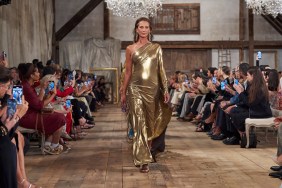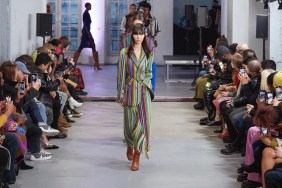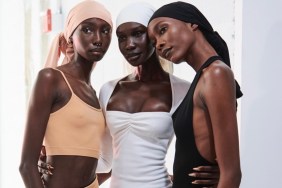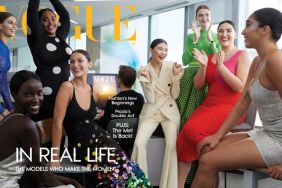“The last two seasons, I’ve seen more young women of color, a greater variety of ladies than I’ve seen in years,” said New York designer Tracy Reese as part of a Glamour live panel on the state of runway diversity which took place this March, following the NYFW Fall 2014 shows. “There are a lot of new faces that are very promising.”
The discussion expanded on a series of ongoing conversations about race in the fashion industry, largely sparked by former modeling agent Bethann Hardison‘s Balance Diversity campaign, which launched in September 2013. Hardison herself participated in the panel, which was hosted by Glamour editor-in-chief Cindi Leive, and also included fashion critic Robin Givhan.
Asked to expand on her remarks, the designer said that she had noticed “a fair improvement” with regards to modeling agencies’ commitment to diversity: “If I broke it down by agency,” Reese hedged, “I’m sure there would be some agencies that are doing a lot better than others. But I’ve definitely seen improvement.”
We decided to see for ourselves: what is the state of diversity at NYC modeling agencies?

We counted the number of models of color included in show packages over two seasons of shows: Spring 2014 (which took place in September, when the Balance Diversity campaign first launched) and Fall 2014 (which took place in February). We worked exclusively with the show packages which were available on Models.com, for the sake of consistency and accessibility. (One agency said that the package that went out to casting directors was not the same one which was available online, but we could not verify that.)
For each agency and each show package, we calculated the number of models of color relative to the total number of models included in the book.
We chose to use “models of color” as an inclusive term referring to any non-white model — black, Asian, non-white Hispanic, Native American, mixed-race, etc.*

We hoped to get a sense of overall industry trends, not compare agencies or point fingers. However, some clear standouts emerged.

“Please note, we take on models that we believe we can develop and market,” said Jody Gordon, the founder of Fusion, when I reached her for comment. “Models are not discriminated on their ethnicity. The truth is, it’s tough finding great models, period. It’s a competitive business and since we are so boutique, we don’t always get the models we want, due to industry politics, etc.”
Fusion represents about a dozen models each season; other small agencies do not have similar percentages. For example: Silent NYC, which included seven or eight models per show package, had zero models of color for both Spring 2014 and Fall 2014. (Silent NYC did not respond to my request for comment.)
Wilhelmina, a larger agency that included 20-30 models per show package, is another standout. The Women’s board director, Roman Young, told me that his agency doesn’t fall prey to the “propaganda that ethnic diversity isn’t what designers or magazines want,” noting that “this past season was the first season that more than just one designer or casting director actually REQUESTED ethnic models to account for greater diversity.”

We also examined whether agencies represented more models of color this season over last September, when the Balance Diversity campaign launched. In most cases, the percentage of change came down to a small handful of models, and is not necessarily statistically significant.
For example: both Wilhelmina and Fusion, which both had the highest average percentage of models of color, also had the highest percentage decrease from one season to the next.
“Some girls aren’t always available to do Fashion Week, so that definitely changed the percentage this past season,” said Fusion’s Jody Gordon.
On the surface, Next Model Management and One Management appear to have made the greatest improvements; I recorded an 8% uptick in non-white models for both agencies. I counted 4 models of color in Next’s show package for Spring 2014 out of 48 models total; the following season, the agency included 7 models of color out of 42 models total. One Management’s numbers show a similar trajectory: for Spring 2014, the agency included 5 models of color, 43 models total; in February, the show package featured 8 models of color out of 41 models total.
In aggregate, combining numbers from all 19 agencies with available show packages for both seasons (Spring 2014 books weren’t available for The Society and Frame Model Management), representation of non-white models improved by only 1 percentage point over the previous season. I counted 93 models of color out of 512 models total for Spring 2014; that’s 18.16% non-white models. For the following season, I logged 97 models of color out of 506 total models, which works out to 19.17%.

Those numbers aren’t surprising. Jezebel, which started compiling data on runway diversity in Fall 2008, found that the number of non-white models cast in NYFW shows increased by only about a single percentage point on the Fall 2014 runways over the previous season, despite the heightened scrutiny.
Frame Model Management was one of the few agencies to openly acknowledge its low numbers and suggest that it was making efforts to sign on new models of color: “Sadly this breakdown is true regarding Frame’s show package diversity this past season,” said booker Eric Granwehr. “However, as we are a very new agency (this past season was our first official full-fledged season), we are still in the midst of assembling a very strong board of new faces that are ready to take on the New York market. It’s really just a luck of the draw sometimes when it comes to domestic and international agencies proposing who they deem as their strongest girls that are suitable for NYFW. Sometimes this includes a selection of several models of color, but sometimes it doesn’t.”
Fusion, another boutique agency, but one that’s leading the industry with its diversity numbers, echoed the sentiment when I asked founder Jody Gordon why so many of her peers were lagging behind: “There is definitely more work and a greater demand for Caucasian models. It’s also tougher to find great ethnic models.”
*Because this is a loose definition and we evaluated on a case-by-case basis, there’s room for error in our findings.
Images in slideshow: screenshot
Model Diversity
-
DNA Models (11.82%*)

Percentage of models of color changed +3% from Spring 2014 to Fall 2014
- Spring 2014 — 29 Models / 3 MOC (10.34%)
- Fall 2014 — 30 Models / 4 MOC (13.3%)
[DNA did not respond to our request for comment.]
*percentage of models of color in show package, averaging Fall 2014 and Spring 2014 seasons
-
Elite NYC (14.72%)

Percentage of models of color changed +2.16% from Spring 2014 to Fall 2014
- Spring 2014 — 22 models / 3 MOC (13.64%)
- Fall 2014 — 19 models / 3 MOC (15.8%)
[Elite NYC did not respond to our request for comment.]
-
Ford Women (13.39%)

Percentage of models of color changed -1.79% from Spring 2014 to Fall 2014
- Spring 2014 — 21 Models / 3 MOC (14.29%)
- Fall 2014 — 24 Models / 3 MOC (12.5%)
[Ford did not comment.]
-
Frame Model Management (10%)

[change n/a]
- Spring 2014 — n/a
- Fall 2014 — 10 Models / 1 MOC (10%)
"Sadly this breakdown is true regarding Frame's show package diversity this past season. However, as we are a very new agency (this past season was our first official, full-fledged season), we are still in the midst of assembling a very strong board of new faces that are ready to take on the New York market. It's really just a luck of the draw sometimes when it comes to domestic and international agencies proposing who they deem as their strongest girls that are suitable for NYFW. Sometimes this includes a selection of several models of color, but sometimes it doesn't."
— Eric Granwehr, booker at Frame.
-
Fusion (46.5%)

Percentage of models of color changed -16% from Spring 2014 to Fall 2014
- Spring 2014 — 11 Models: / 6 MOC (54.5%)
- Fall 2014 — 13 models / 5 MOC (38.5%)
"I don’t think agencies have a great deal of influence, however, if you have a strong ethnic girl, chances are people will notice her more quickly than a Caucasian girl. So the chances of her career moving more quickly is definitely greater. However, agencies are a middle man, at the end of the day, designers/stylists will ultimately decide who they want to use in their show. It’s all about what they feel is going to sell their collection the best."
— Jody Gordon, founder of Fusion
-
IMG (21.15%)

Percentage of models of color changed +1.7% from Spring 2014 to Fall 2014
- Spring 2014 — 64 Models / 13 MOC (20.3%)
- Fall 2014 — 68 models / 15 MOC (22%)
[IMG did not respond to our request for comment.]
-
Major Model Management (25.4%)

Percentage of models of color changed +3.2% from Spring 2014 to Fall 2014
- Spring 2014 — 42 Models / 10 MOC (23.8%)
- Fall 2014 — 37 Models / 10 MOC (27%)
"MMM has always been proud of its diverse board... and I believe it's also a reflection of the agency itself. If you walk into Major you will see every color of the rainbow. The bookers, our President is half Egyptian and half French.
<p<
There certainly has been an increase [in diversity] when it comes to print. You see it in the campaigns, cosmetic brands... usually a girl from every racial background. Now when it comes to shows, it's been a bit more of a challenge. Some designers are more progressive than others."</p<
— Domonick Hannosh, booker at Major Models.
<p<
</p<
-
Marilyn Models (13.36%)

Percentage of models of color changed +4.49% from Spring 2014 to Fall 2014
- Spring 2014 — 18 Models: / 2 MOC (11.11%)
- Fall 2014 — 32 Models / 5 MOC (15.6%)
"Marilyn Agency supports diversity in all aspects of the fashion industry, not limited to runway. We are happy to announce our next package will feature an even greater amount of models from all backgrounds.
While Marilyn Agency has noticed an increase in demand for models of color we always think the demand could be greater!"
— Marilyn Models representative
-
Next Models (12.47%)

Percentage of models of color changed +8.72% from Spring 2014 to Fall 2014
- Spring 2014 — 48 Models / 4 MOC (8.33%)
- Fall 2014 — 42 models / 7 MOC (16.6%)
[Next Models did not comment.]
-
New York Model Management (23.67%)

Percentage of models of color changed -0.84% from Spring 2014 to Fall 2014
- Spring 2014 — 29 Models / 7 MOC (24.14%)
- Fall 2014 — 30 models / 7 MOC (23.3%)
[New York Model Management did not respond to our request for comment.]
-
One Management (15.57%)

Percentage of models of color changed +7.87% from Spring 2014 to Fall 2014
- Spring 2014 — 43 Models / 5 MOC (11.63%)
- Fall 2014 — 41 Models: 8 MOC (19.5%)
[One Management did not comment.]
-
Q Model Management (14.17%)

Percentage of models of color changed -8.33% from Spring 2014 to Fall 2014
- Spring 2014 — 18 Models: / 6 MOC (33.33%)
- Fall 2014: 16 Models: 4 MOC (25%)
[Q Model Management did not respond to our request for comment.]
-
Red Model Management (29.7%)

Percentage of models of color changed +0.6% from Spring 2014 to Fall 2014
- Spring 2014 — 17 Models / 5 MOC (29.4%)
- Fall 2014 — 9 Models / 3 MOC (30%)
[Red NYC did not respond to our request for comment.]
-
Silent NYC (0%)

Percentage of models of color did not change from Spring 2014 to Fall 2014
- Spring 2014 — 7 Models / 0 MOC (0%)
- Fall 2014 — 8 Models / 0 MOC (0%)
[Silent NYC did not respond to our request for comment.]
-
Supreme Model Management (8.47%)

Percentage of models of color changed +0.27% from Spring 2014 to Fall 2014
- Spring 2014 — 36 Models / 3 MOC (8.33%)
- Fall 2014* — 35 Models / 3 MOC (8.6%)
[Supreme Model Management did not comment.]
*Fall 2014 show package = (Main — 21 Models: 1 MOC) + (Development — 14 Models: 2 MOC)
-
The Lions (5.25%)

Percentage of models of color changed +10.5% from Spring 2014 to Fall 2014
- Spring 2014 — 16 Models / 0 MOC (0%)
- Fall 2014 — 19 Models / 2 MOC (10.5%)
[The Lions did not comment.]
-
The Society (20%)

[change n/a]
- Spring 2014 — n/a
- Fall 2014 — 35 Models / 7 MOC (20%)
[The Society reviewed and confirmed their numbers.]
-
Trump Models (22.62%)

Percentage of models of color changed +1.76% from Spring 2014 to Fall 2014
- Spring 2014 — 23 Models / 5 MOC (21.74%)
- Fall 2014 — 17 Models / 4 MOC (23.5%)
[Trump Models did not respond to our request for comment.]
-
Wilhelmina Models (33.35%)

Percentage of models of color changed -9.49% from Spring 2014 to Fall 2014
- Spring 2014 — 21 Models: / 8 MOC (38.09%)
- Fall 2014* — 28 Models / 8 MOC (28.6%)
"Bethann Hardison [is] the driving force in building a coalition of industry people that celebrate and strive for runway presentations that are more representative of what we see on the streets of the coolest cities in the world."
— Women's board director, Roman Young
*When asked to review our figures, Wilhelmina's women's board director Roman Young said that the show package sent to casting directors featured 17 models of color out of 38 models total. This show package, he said, was not the one available on Models.com.
For the sake of consistency (I pulled all agency show packages from Models.com) and because I was not able to independently review the 38-model book, I retained my original numbers, which were based on the show package available online.
-
Women Direct (31.67%)

Percentage of models of color changed -3.33% from Spring 2014 to Fall 2014
- Spring 2014 — 12 Models: / 4 MOC (33.33%)
- Fall 2014 — 6 Models / 2 MOC (30%)
[Women Direct did not comment.]
-
Women Model Management (14.82%)

Percentage of models of color changed -6.64% from Spring 2014 to Fall 2014'
- Spring 2014 — [26 Models / 4 MOC (15.38%) + by request — 9 Models / 2 MOC (22.22%)] — Total: 17.14%
- Fall 2014 — 32 Models / 4 MOC (12.5%)
[Women Model Management did not respond to our request for comment.]







